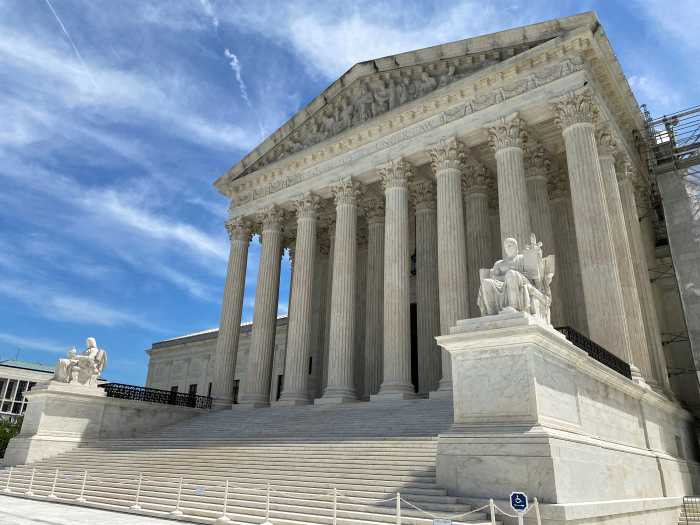The Richmond-based US Court of Appeals for the Fourth Circuit ruled on April 29 that North Carolina and West Virginia violated the Equal Protection rights of transgender people by providing health insurance programs that exclude coverage of some or all gender-affirming care for transgender people.
The court combined separate appeals by the two states from district court decisions that had rejected the states’ defenses of their exclusionary policies, with 14 members of the circuit court participating in deciding the appeal.
The court’s decision to bypass the usual three-judge panels to take a first crack at reviewing the district courts’ decisions and to jump directly to an “en banc” review raised some eyebrows, but as a logistical matter it certainly made sense. Under circuit court procedures, the first panel to rule would have set a precedent for the circuit, which would then be binding on the other panel unless overturned “en banc” or by the Supreme Court, so it seemed prudent and expeditious to skip the three-judge panels. That also means that the underlying legal issues can get to the Supreme Court faster, if need be to resolve differences between the Fourth Circuit and other circuits.
The Fourth Circuit’s ruling may light a fire under the Supreme Court, as it has put off deciding whether to grant review of petitions from Kentucky and Tennessee, where a Sixth Circuit ruling last year overturned preliminary injunctions issued by district courts against state bans on gender-affirming care, and transgender plaintiffs have been urging the court to take up the cases and reverse that ruling. The Biden administration also filed a petition asking the court to take and reverse the Sixth Circuit case. Briefing on those petitions was concluded in March, and the case has been on the Court’s conference agenda for six conferences. Each time they rescheduled it for later consideration. Perhaps the court was deliberately waiting to see what the Fourth Circuit would do, as this appeal had been argued on Sept. 21, 2023, and an opinion could be issued at any time. If the Fourth Circuit finally disagreed with the Sixth Circuit, that would be a signal to the Supreme Court that a serious circuit split needed to be resolved, both as to the Equal Protection Clause and the Affordable Care Act.
The North Carolina case involves the state insurance plan for teachers and other state workers. The West Virginia case involves the state’s Medicaid program, which provides health insurance for people whose household income falls below a statutory threshold. Because these are both government-run programs, they are subject to the Equal Protection requirements of the 14th Amendment of the Constitution, which provides that no state may deny any of its residents equal protection of the laws. Because both states’ programs receive some federal funding, they are also subject to the non-discrimination requirements of the Affordable Care Act, which forbids discrimination “because of sex.” And, of course, West Virginia’s Medicaid program must comply with the coverage requirements of the federal Medicaid Act, under which the federal government provides substantial funding in support of state Medicaid programs.
The North Carolina insurance plan excludes from coverage “treatment or studies leading to or in connection with sex changes or modifications and related care,” thus effectively excluding coverage of all gender-affirming care for transgender individuals. West Virginia’s Medicaid program does cover some gender-affirming care but not surgery, which the program anachronistically calls “transsexual surgery.” In both states, transgender individuals obtained representation from Lambda Legal, assisted by local counsel, in filing challenges to these exclusions. Numerous amicus briefs have been filed, most notably by states opposing or supporting the exclusions.
The Fourth Circuit has 15 judges, one of whom was installed just a few weeks ago and did not participate in this case, which was argued back in September. The vote of the remaining judges was 8-6. All of the judges in the majority were nominated by Democratic presidents. All of the dissenting judges were nominated by Republican presidents. Judge Roger Gregory wrote the majority opinion, joined by Chief Judge Albert Diaz and Circuit Judges Robert Bruce King, James Andrew Wynn, Stephanie Thacker, Pamela Harris, Toby J. Heytens, and DeAndrea G. Benjamin. Dissenting Circuit Judges included J. Harvie Wilkinson III, Paul V. Niemeyer, G. Steven Agee, Julius N. Richardson, A. Marvin Quattlebaum Jr., and Allison Jones Rushing, all of whom joined in a lengthy dissenting opinion by Judge Richardson, with shorter separate dissents by Judges Wilkinson and Quattlebaum.
Most of the contention between the majority and the dissenters was about how to characterize the exclusionary provisions. The majority saw them as discrimination because of the transgender identity of the individuals seeking coverage for their gender-affirming care, subject to heightened scrutiny under Equal Protection doctrine, which places the burden on the state to show that the exclusions substantially advance an important state interest. The majority described the exclusions as being a “proxy” for discrimination because of gender identity. A key factor in the majority’s analysis was evidence that the medical treatments involved in such care are not covered for transgender people seeking them to affirm their gender identity but are covered for cisgender people seeking them for other purposes, including affirming cisgender identity.
For example, a cisgender woman can be covered for a medically necessary mastectomy as a treatment for breast cancer, but a transgender man is not covered for a mastectomy performed to affirm their male gender identity. A cisgender boy diagnosed with delayed puberty will be covered for testosterone treatments to stimulate the development of secondary male sex characteristics, but a transgender boy will be denied coverage for testosterone to affirm their male identity. To the majority, this was direct evidence of discrimination because of both gender identity and sex.
The states argued that there was no discrimination based on transgender status but rather a distinction based on medical diagnosis, and that no Equal Protection issue was triggered by these exclusions. The majority of the court rejected this argument. Judge Gregory’s opinion goes on at great length to show how the dissenters’ analysis was not faithful to federal discrimination law precedents.
The Medicaid Act requires states to cover both mandatory and optional services in sufficient “amount, duration, and scope to reasonably achieve its purpose.” Although states can “place appropriate limits on a service based on such criteria as medical necessity or on utilization control procedures,” say the regulations issued under the Act, they cannot “arbitrarily deny or reduce the amount, duration, or scope of a required service to an otherwise eligible beneficiary solely because of the diagnosis, type of illness, or condition.”
The majority of the court found that West Virginia’s exclusion of “transsexual surgery” from Medicaid coverage did exactly what the regulation forbids, reducing the scope of a required service “solely because of the diagnosis, type of illness, or condition.” A person identified as female at birth can get a mastectomy for a cancer diagnosis, but not for a gender dysphoria diagnosis, for example.
The states argued, without success, that the availability of particular treatments or surgery was based not on the sex or gender identity of any individual, but rather based on the diagnosis they received. Although the words weren’t pushed openly, the states’ arguments reflected the view that a mastectomy for breast cancer involves removing a diseased body part, while a mastectomy in aid of achieving a masculine body for somebody identified as female at birth involved removing a healthy organ for psychological rather than medical reasons. In short, legislatures that exclude gender-affirming care from their insurance programs generally reflect the Republican Party’s ideological rejection of the reality of gender identity. (This insistence by Florida legislators led one federal district judge to write in his opinion striking down an anti-trans law that “transgender identity is real!”)
The Affordable Care Act prohibits discrimination because of sex in insurance programs that receive federal funding. Both the North Carolina and West Virginia programs receive federal funding and, applying the same reasoning as it did in its Equal Protection analysis, the court found that refusing gender-affirming care when the individual is transgender is a form of sex discrimination prohibited by that Act.
The majority opinion also dealt with important subsidiary issues such as certifying a plaintiff class action, the wording of the injunctions the district courts issued requiring the state programs not to enforce their exclusionary provisions, and rulings on admission or exclusion of “expert testimony” that the states wanted to present to support their defense of the exclusions.
Judge Richardson’s dissent was joined in whole or in part by all the other dissenters. He disputes the majority’s conclusions on every point, embracing the states’ arguments that their exclusionary provisions do not discriminate because of sex, and pointing out further that the Equal Protection Clause does not even mention sex and, as construed by the Supreme Court, follows a different methodology from the civil rights statutes that do mention sex.
In a separate dissent, Judge Wilkinson argues against deciding the case as a matter of constitutional law. “Why the rush to constitutionalize?” he asks. “Why the dash to create a substantive Fourteenth Amendment right to transgender surgery and treatment underwritten by the state?” He argues that taking such an approach introduces too much politics into what should be a process of strict legal analysis. “The fundamental rights prong of equal protection is what is at play here, and while constitutionally mandating state-funded transgender rights will please some, it will politicize the courts in the eyes of all as assuredly as its substantive due process predecessor did.”
Judge Quattlebaum’s separate dissent focuses on the dispute between the parties over whether the states have a legitimate basis not to finance gender-affirming care. “We do not — or, at least, we should not — bend the Federal Rules of Evidence just because a case involves important constitutional issues,” he wrote. “But that is what the majority seems to be doing here. In order to conclude that no legitimate, non-discriminatory reasons support denying coverage for certain treatments of gender dysphoria, the majority abandons settled evidentiary principles. Properly accounting for the record, questions about the medical necessity and efficacy of such treatments linger. And those lingering questions support the state’s coverage decisions.”
Quattlebaum is referring to the “expert testimony” offered by the states in support of their exclusionary policy, which was either excluded or discounted by the trial judges in these cases, who gave great weight to the amicus briefs offered by the major medical associations in support of gender-affirming care for persons diagnosed with gender dysphoria.



































